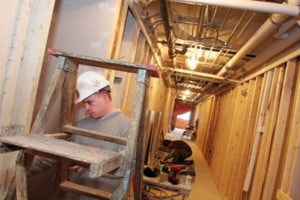With a little more time, the Canada Winter Games athletes’ village project might have been done differently, said project manager Mike Frasher.
The two structures might have been stick-built, an almost impossible scenario given the tight timeline between when the Yukon government officially took over the project, in May 2005, and February 24, 2007, when the Games begin.
However, the modular construction with ATCO units might still have been the method of choice, said Frasher.
The project would still have cost somewhere in the neighbourhood of $31.4 million, he said.
The government would still have been involved.
And, at the end of the day, there would still be two new buildings next to Yukon College to house 1,500 athletes next year, and a lasting legacy of affordable housing for students and low-income families, said Frasher.
“This is what we’ve been able to achieve now, in less than eight months,” Frasher said Thursday, looking on as about 90 workers hustled around the construction site, climbing ladders, laying shingles, and operating cranes loaded with beams for Building A.
“We’re pretty pleased.”
Building A is going to be a student residence.
The four-storey structure is almost complete, just a roof to finish, with lots of work left to be done inside, on 12 two-bedroom suites and 12 three-bedroom suites and the stairwells and corridors that connect them.
The drywall is mostly bare; there’s plastic on the floors and while the bathrooms and kitchens are in place there’s no running water, yet.
It took a lot of nails, still exposed on the walls, to hammer the units together. They came pre-fabricated from Calgary, Alberta, complete with wiring, plumbing and ventilation.
All the services infrastructure is connected through a central core, with large boilers already bolted to the basement floor.
“The buildings are built to code,” said Frasher.
“They are a residence facility, built for the long term, 60 or 70 years.
“They are finished units, ready for occupancy.”
For the Games, the units will be filled with bunk beds.
Twenty-three athletes, plus their personal gear, will be crammed into each three-bedroom suite.
Those unfortunate enough to wind up in the basement and miss out on the spectacular views of Grey Mountain will fill 27 eight-person dormitories, with large bathrooms at either end of the building.
The host society won’t know the total athlete head count until four weeks prior, but it’s roughly 1,800 each week, said spokesman Chris Morrissey.
The village will house only the athletes and their gear. For the Games, food will not be allowed in the buildings.
The college will provide all the meal facilities and meeting spaces.
“We’ve been working with the administration at the college,” said Morrissey.
“The college will be closed for a two-and-a-half week period.”
Students and instructors are aware that they will need to prepare for the closure, he said.
Two weeks of missed classes makes for a lot of homework.
But Morrissey is hoping students and staff will join the much-needed corps of volunteers.
The Games are becoming more sophisticated, he said.
They require a lot of time, organization and money, not to mention up-to-date building codes and permits.
Whitehorse made its bid to host the Games in 2000, and won in early 2001 with a $2.7-million proposal.
“We looked at the net cost of a village,” said Morrissey.
“We were always talking modular units, but we needed to identify an end user.”
The host society wanted to employ Yukon companies as much as possible, and it did commission a master plan from Kobayashi & Zedda Architects Ltd., he said.
But responses to the society’s request for proposals didn’t include financing or identified end users, said Morrissey.
Altogether, the future students’ residence will contain 24 units.
“When the athletes leave, we’ll do touchups, clean them and they’ll be ready for use,” said Frasher.
Building B — twice the size, with 48 single and double suites — isn’t open for public scrutiny yet.
The basement will hold 43 dorm rooms and four large bathrooms.
It’ll be converted to affordable housing for the Yukon Housing Corporation, after the Games.
Overall size of the project totals 140,000 square feet.
With a $28.5 million budget for construction, it comes to about $200 per square foot — “a pretty common cost for construction,” said Frasher.
“Inflation for construction materials has been rising over the past few years. They’re going up every week.”
The work deadline is November 1, 2006, roughly four months before the Games begin.
